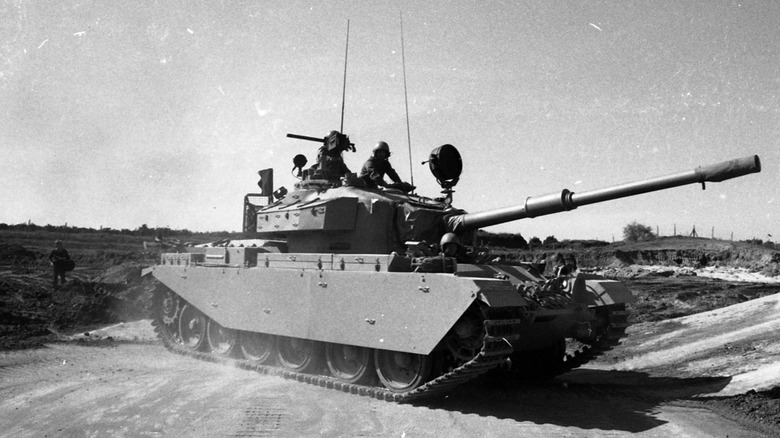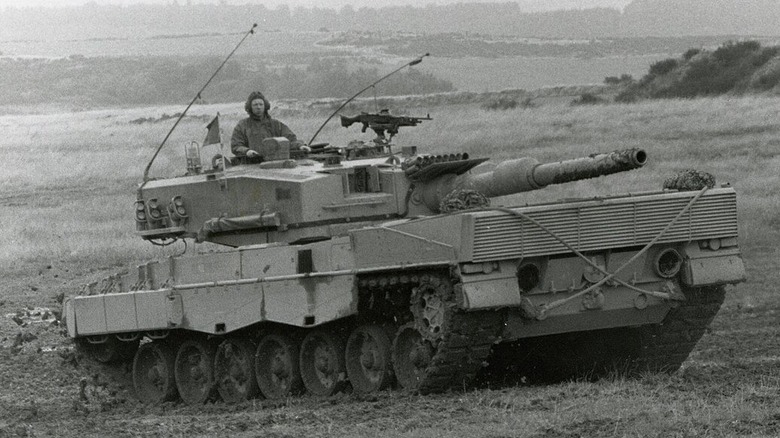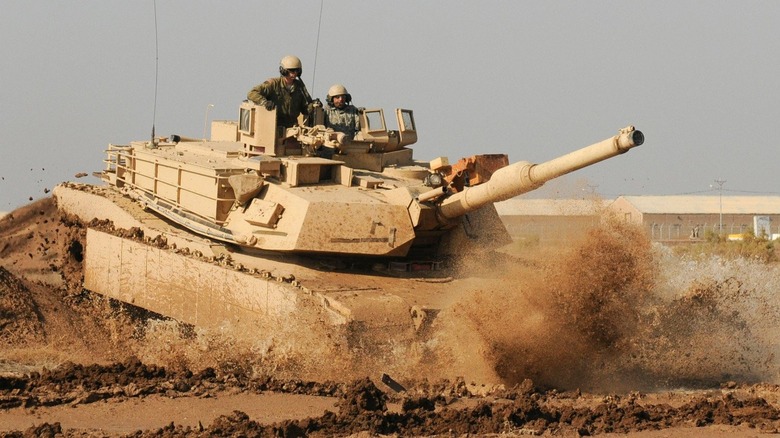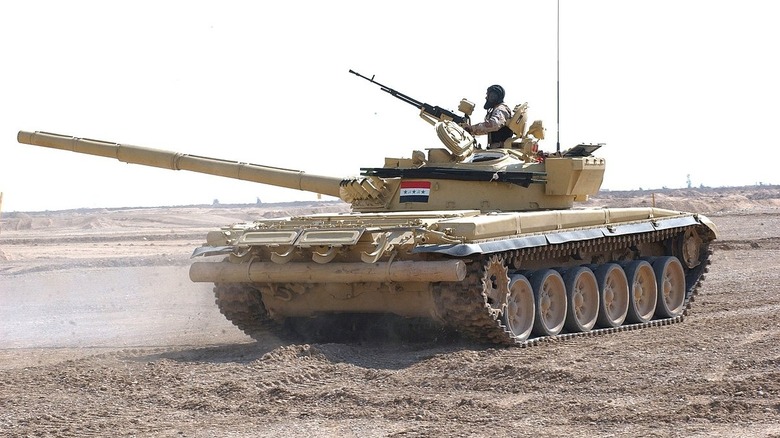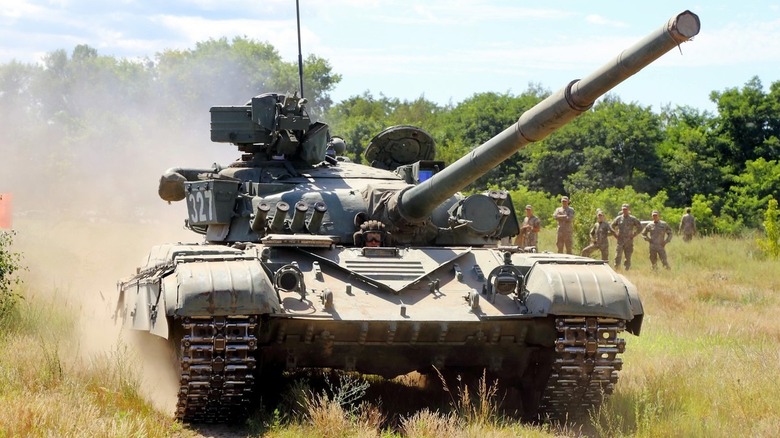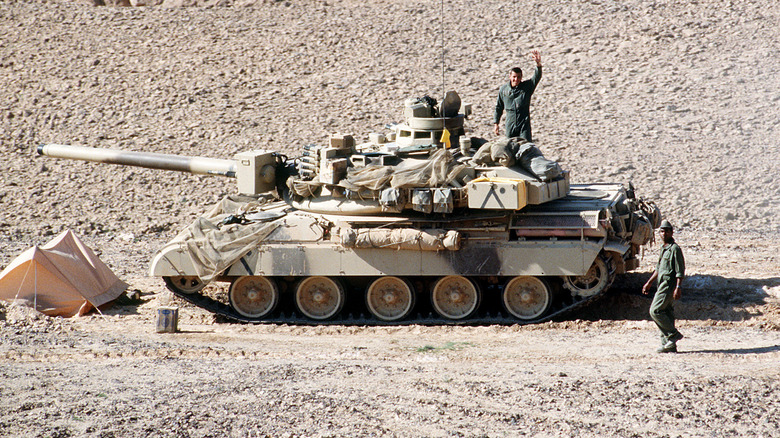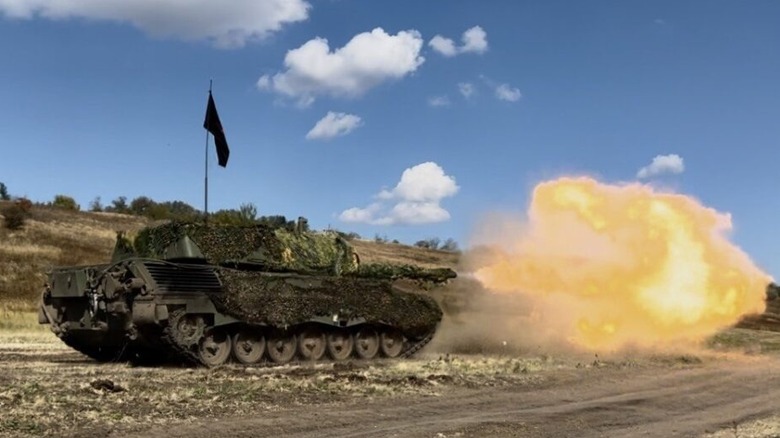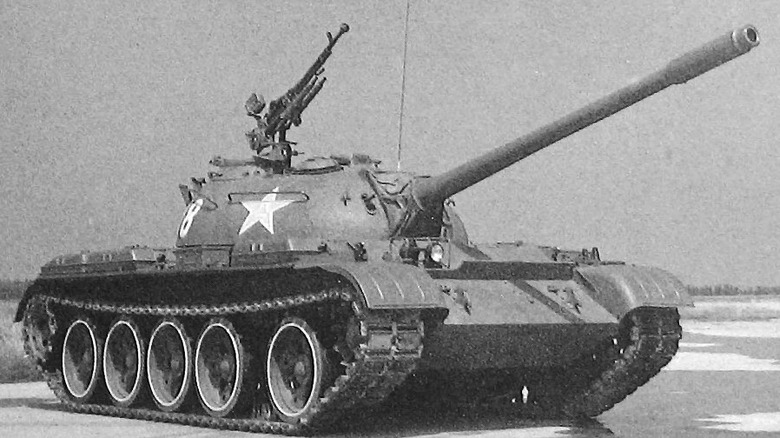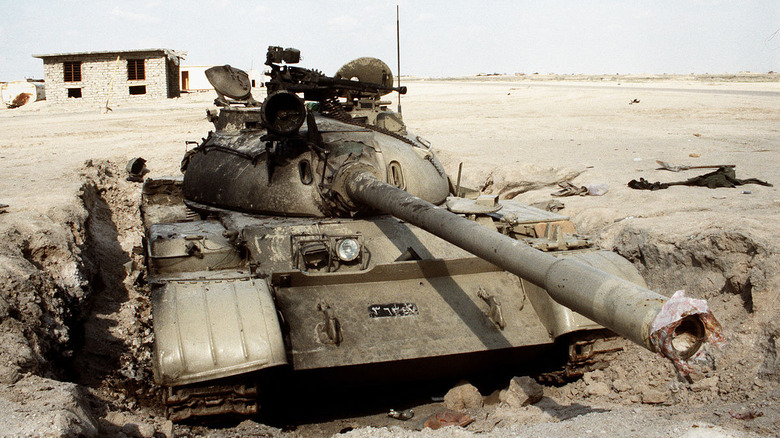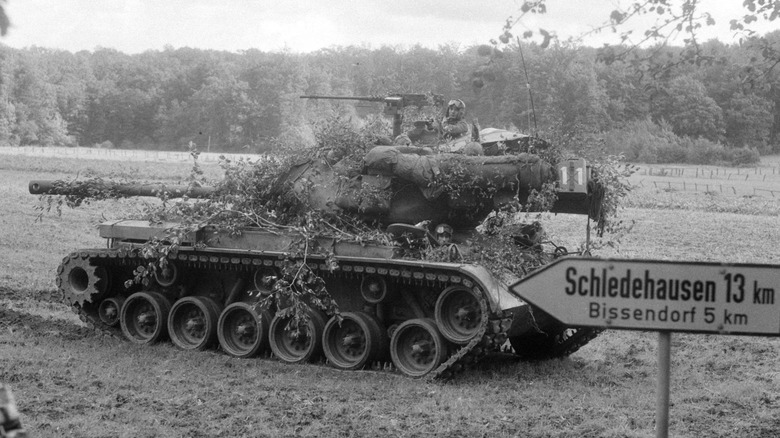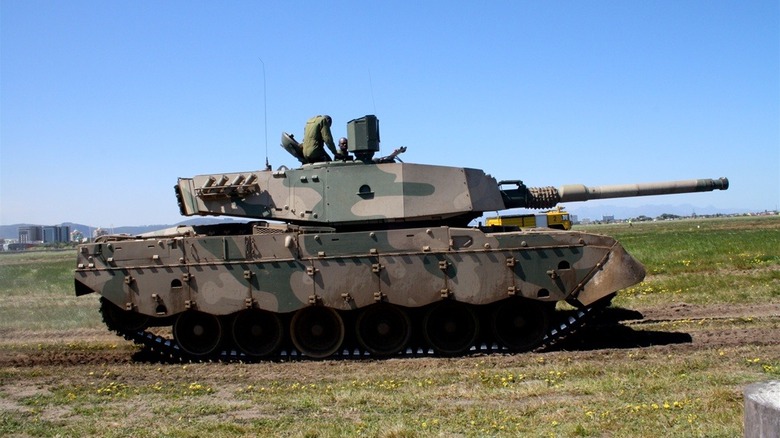13 Of The Oldest Tanks Still In Service Today, Ranked By Age
Tanks are an integral part of any fighting force worth its salt. They provide heavy firepower, mobility, and armor, allowing an army to advance through enemy fire while hitting back with explosive ferocity. This strength and utility come at a major financial expense. Tanks cost millions of dollars to procure, with maintenance and ammunition adding millions more to that price over time. As such, most armies don't have the luxury of completely replacing their roster of tanks every decade.
Instead, many countries make an effort to ensure that their tanks last as long as possible, buying them from other countries and upgrading weapons and armor that turn antiques into modern war machines. Just because something is old doesn't mean it's obsolete, and with proper love and care (and a skilled mechanic), a tank with the right core design can last decades. Read on to learn about 13 of the oldest tanks still in service today, ranked by age.
Leopard 2A4
The Leopard 2 tank was developed by Germany in the 1970s. True to the tenets of German engineering, the Leopard 2 was built to last and has seen numerous iterations over the years. Its most popular variant is the Leopard 2A4, which began manufacturing in 1985. The 2A4 improved on the original Leopard 2 by upgrading its armor and adding a fire-suppression system to the interior, allowing otherwise compromised units to keep on fighting if the interior fire damage wasn't too debilitating.
Today, the Leopard 2A4 is in widespread use around Europe. In 2023, countries like Poland, Norway, and Finland donated dozens of these tanks to Ukraine to help the country defend itself from Russia's unprovoked war of senseless aggression. In a related story, Croatia is upgrading its tank fleet to Leopard 2A8, and in return, has pledged to donate its existing stable of M-84 tanks to Ukraine's war effort. The M-84 is based on the T-72, but we'll have more to say about that model later on.
M1 Abrams
When one thinks of a modern American tank, they think of the M1 Abrams. Since entering service in 1980, the M1 and its intimidating, angular silhouette has been a symbol of armored supremacy. Despite its massive size and weight, the M1 can reach speeds in excess of 40 MPH on a solid road and 25 MPH over off-road terrain. The image of M1 tanks racing across the sand during Operation Desert Storm is a defining image of the early 1990s, and the M1 could be seen as the face of that particular war, the signature piece of hardware that defined the conflict.
The United States donated no fewer than 31 M1A1 tanks to Ukraine for its ongoing war against Russian aggression. Australia, in the midst of upgrading its fleet to the M1A2 model, donated its retired M1A1 models to Ukraine, where they can do some good against Russia's forces. As of this writing, about 40 Australian tanks have made their way to Ukraine. Unfortunately, many of Ukraine's M1s have been pulled from active combat, with Ukraine and the United States forced to adapt to Russian hunter-killer drones and their ability to hit the M1 at its most vulnerable weak points. As a result, Ukraine has retooled the unit with cage screens and explosive reactive armor to give it more survivability against Russian tactics.
T-72
This Soviet-era tank entered service in 1972 as a competitor to the T-64 model (but more on that one in the next entry). The T-72 was used in many Soviet/Russia-adjacent conflicts during and after the Cold War, such as the Iraq-Iran War, the 1982 Lebanon War, and the Chechen wars. Thanks to its status as a relatively inexpensive piece of hardware, the T-72 has popped up in seemingly every war around the world since its inception, including the 2015 Boko Haram conflict in Nigeria, the Georgian Civil War, the Rwandan Civil War, and many others.
Most recently, the T-72 saw use on both sides of the Russian-Ukrainian War, from the 2014 conflict in Donbas to the ongoing full-scale invasion. In addition to their own supply of T-72s, Ukraine received aid in the form of additional units from Poland and the Czech Republic. As of this writing, more than 300 Ukrainian T-72s are believed to have been in combat against Russian forces, while Russia has possibly seen more than 1,200 destroyed in Ukraine.
T-64
Unlike the previous tanks, the T-64 was assembled in Kharkiv, Ukraine, back when the country was part of the Soviet Union. The tank was developed in the early 1960s, but wasn't officially adopted by the Soviets until 1967, 4 years after the army received its first units. After the fall of the Soviet Union, Ukraine continued maintaining and upgrading its T-64s in an attempt to keep them competitive against more modern tanks.
When Russia began its full-scale invasion of Ukraine in 2022, it was all hands on deck for the defenders. Despite upgrading its fleet to advanced modifications of the T-64B and further variants, older models were seen on the battlefield, used by the Ukrainian military and `Russian-funded separatists in the Donbas region. As of this writing, roughly 600 Ukrainian T-64s have been destroyed or captured by Russia. Elsewhere in the world, Congo has a small fleet of T-64B1M tanks purchased from Ukraine in 2016.
AMX-30
In the realm of tabletop role-playing games, there's a term, 'glass cannon,' that refers to characters that are powerful but frail, capable of dishing out major pain but not of taking any significant damage themselves. When it comes to battle tanks, the French AMX-30 is the tank equivalent of a glass cannon. Its armor was enough to protect against small arms fire, but when it came to tank-on-tank combat or heavier artillery, the AMX-30's greatest defensive asset was its speed (thanks to lack of armor!) and 105mm cannon that could theoretically take care of most threats before they would have a chance to fire back.
The AMX-30 was developed in the 1960s and first saw action in 1973 during the Athens Polytechnic uprising, though a tank facing off against a group of anti-military students could hardly be considered action. But let's not get overly political while fawning over tanks. The AMX-30 was used by Qatar and France during the Gulf War, and several countries still have units in service.
Leopard 1
The German Leopard 1 dates back to 1965. Despite being ostensibly replaced by its successor, the Leopard 2 and its variants, the original Leopard remained competitive in the realm of armored combat. With its light weight (for a tank) and 105mm main gun, the Leopard 1 was ahead of its time in both mobility and firepower, traits that continue to be useful in modern warfare. Today's wars are said to be high-tech and computer-guided, but when it comes right down to it, destruction is always barbaric, and sometimes you need an old-school machine to get the job done.
In addition to Leopard 2 variants, countries like Germany, Denmark, and the Netherlands have donated over one hundred units of the Leopard 1 and its variants to Ukraine. This includes the prototype Leopard 1A5BE with a new, unmanned turret. This experimental weapon adds modern technology to a classic frame, breathing new life into the classic death-dealer. It's much more cost-effective to develop new additions to established weapons than to develop a whole new tank. It's efficient, as well as a testament to the lasting legacy of the Leopard 1.
Type 59
The Type 59 tank was developed by China in the late 1950s and officially entered service in 1959, which gave it the name. Based on the Soviet Union's T-54 from 1946, the Type 59 saw combat in the Vietnam War, wherein it was used by North Vietnamese Army (NVA) forces against American tanks like the M41 Walker Bulldog (but more on that one later). Its 100mm cannon proved effective against Western armor, but handheld weapons like the RPG-7 were generally more effective for the local forces, as befitting a guerrilla army relying on hit-and-run tactics more than direct, head-to-head confrontation.
As of 2024, China still has 400 Type 59 derivatives in use, and it's widespread in countries like North Korea, Congo, Iran, Pakistan, and Sudan. So, if there's a war in the Middle East or central Africa, it's a safe bet you'll see some Type 59 tanks on the battlefield. Though production of the tank ceased in the 1980s, it remained in service, with existing units avoiding obsolescence via upgrade kits. Bangladesh has its own variant of the tank, called the Type 59 Durjoy. Introduced in 2015, it's distinctly a Type 59, but with a system-wide upgrade that makes the vehicle competitive with modern tanks.
T-55
The aforementioned Chinese Type 59 was based on the T-55, a Soviet tank from the post-WWII era. Combined with its sister-tank, the T-54, the T-54/T-55 series is among the most widely adopted tanks in the world, and the foundation of tons of variants and derivatives. When one thinks of a tank, this is likely the image that will form in one's head. Like many of the Soviet-era tanks on this list, the T-55 is currently being used in the war in Ukraine, with both sides utilizing T-55 units, though Ukraine's are more viable than the obsolete, non-upgraded versions used by a desperate Russia.
Outside of former Soviet nations, the T-55 is widely used across Asia, Europe, and even South America, and has thus seen action in virtually every war since its inception. Many of today's T-55s have been upgraded beyond the capabilities of their post-WWII originals, but at their core, they're the same machine that was built on a Soviet assembly line in 1956, with its roots in the original T-54, which first entered service in 1946.
M-47 Patton
General George S. Patton is arguably the single most recognizable figure in the history of the American military. He fought in World War I, and his tactical thinking helped the Allies win World War II. The M47 tank bears his name and, like the man himself, was one tough piece of American hardware. Unlike the man himself, the M47 Patton was never put to the test in American service, as it never saw combat, at least not with the U.S. Army.
Iran used M47s during the Iran-Iraq war, and Turkey utilized them during their invasion of Cyprus in 1974. Today, the only country that still uses the M47 is Iran. However, a particular M47 still sees action, of a sort, in the United States. Arnold Schwarzenegger, during his time in the Austrian army, operated an M47 tank. In the 1990s, he purchased that same tank and rented out rides to raise money for charity, where winners could ride along with Arnold and crush objects in a scrapyard behind the controls of the M47.
M41 Walker Bulldog
One of America's Cold War-era tanks, the M41 Walker Bulldog was named after General Walton Walker, a WWI, WWII, and Korean War veteran who died in a jeep accident in 1950. Initially produced in 1951, the M41 was developed as a replacement for the WWII-era M24 Chaffee. The Walker Bulldog tank wasn't the most popular among barrel-chested American soldiers due to its bulky exterior and cramped interior. It was quickly sidelined in favor of the aforementioned M47 Patton and, later on, the M551 Sheridan.
The Walker Bulldog was subsequently sold to American allies like South Vietnam. The vehicle was used in the Vietnam War, but was outclassed by the Communists' PT-76 and T-54 tanks, as well as land mines, AT-3 guided missiles, and RPG-7 attacks. Today, the M41 remains in service in Taiwan, the Dominican Republic, Thailand, and Uruguay. Ultimately, if we had to serve on board any of the tanks on this list, the M41 Walker Bulldog would be at the bottom of the list, surely to the chagrin of Walton Walker's ghost.
Centurion/Olifant
The British Centurion tank was developed during World War II to counter the fearsome German Tiger, but it wasn't completed until 1945, after the war was over. Still, the effort didn't go to waste, since the Centurion and its variants remained in service long enough to be deployed during Operation Iraqi Freedom in 2003.
South Africa adopted its own version of the Centurion, rebuilding the frame as the Olifant, effectively a brand new tank utilizing the same hull, but with entirely different systems under the hood. It's like a mechanic taking the shell of an old muscle car and replacing the guts, interior, engine, tires, and everything else with brand new components. Elsewhere in the world, the country of Jordan reused Centurion frames to build its Temsah APC, and Israel also utilizes armored vehicles that are essentially converted Centurions. While the Centurion itself might not officially be in service anymore, its legacy lives on through new vehicles made from its old, salvaged parts.
M3 Stuart
During World War II, Allied forces were in a desperate race to catch up to Nazi Germany's tank supremacy. The deployment of the M3 Stuart in 1941 helped even the odds against Germany's armored vehicles, ultimately playing a part in leading to the defeat of Nazi Germany in 1944. The M3 was an adaptable piece of hardware, capable of supporting infantry with multiple M1919 machine guns and a 37mm main cannon for harder targets.
Though the M3 was usurped almost immediately by its successor, the M5, the M3 remained in service, both in the United States and abroad. The M3 was used by armies around the world for decades. As of this writing, however, only a single country still utilizes the M3, and that country is Paraguay. Their dozen-or-so M3 units are mostly used for training purposes, but if Paraguay suddenly gets invaded by a rival nation, they'll find themselves going up against a surprisingly spry octogenarian.
T-34
As far as we can tell, the oldest tank still in service is the T-34. This Soviet tank was developed during World War II and first saw action in 1941's Operation Barbarossa, a Nazi invasion of the Soviet Union, but they were stopped dead in its tracks by the new T-34, which immediately cemented itself as a force to be reckoned with. However, due to various factors such as inexperience, poor training, and a lack of radios in the tanks, the Soviet Union's T-34s were still destroyed in large numbers. Maybe Stalin's "Great Purge," which led to the deaths of hundreds of thousands of dissenters within his own Communist Party, including many military officers, wasn't such a good idea after all.
Though it was replaced by the T-44 by the end of World War II, the T-34 kept on trucking, especially in countries that lack funds to invest in hardward, like North Korea, Laos, and Cuba. As for actual combat, the T-34 hasn't been seen on the frontlines of any conflict in recent years, with the Houthi coup in Yemen in 2015 being the latest. While it's certainly an old-fashioned piece of equipment and has been outclassed by decades of progress in the military technology sphere, we still wouldn't want to find ourselves face-to-turret against a T-34 tank.
